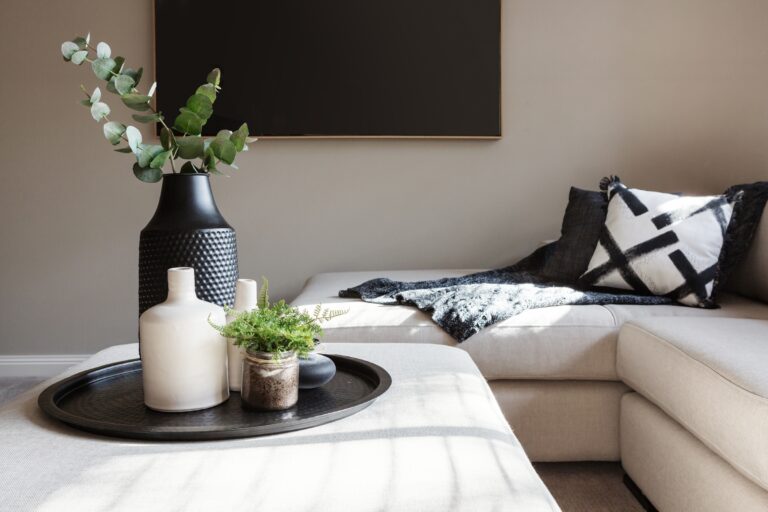Before you dive into your next dreamy design project, it’s important to have a contract that lays out all the essentials. Think of it like your favorite cozy blanket—it keeps things comfy, secure, and stress-free.
Your design contract should cover everything from the scope of work to how changes (and extra fees) will be handled. Make sure it includes how approvals, revisions, and payments will flow, and don’t forget to add little details like timelines, meetings, and who’s responsible for what. It’s also smart to include sections on confidentiality, termination, and even photography rights for those gorgeous before-and-after shots.
When you have these bases covered, you can focus on what you love most—creating beautiful, breezy spaces—without any unexpected surprises.
Keep reading for 9 great contract templates and all the expert guidance you need to customize contracts for client projects, whether you offer full service design, e-design, or decorating.

Table of Contents
10 interior design contract templates
Check out these examples of interior design contracts, all of which are templatized so you can use them for your own business. We’ve got templates across a variety of prices, including three templates that are completely free to use.
For the Google Doc, Microsoft Word, and Canva templates, you’ll need to customize them and then upload them into an e-signature platform to get a legally binding signature from your client.
1. Interior Design Contract Template – DesignFiles
Download Your
Free Interior Design Contract Template
- Customizable contract for design projects
- Covers scope, payments, revisions, and more
- Easy to edit, personalize, and send for sign-off
- Includes usage tips and e-signature guidance

Where interior designers
come to get organized
If you’re looking for a professional, ready-to-use contract to streamline client onboarding and protect your interior design business, this free template from DesignFiles is a great place to start.
Created specifically for residential interior design projects, this downloadable contract includes clearly labeled, editable fields so you can easily tailor it to your services—whether you offer full service, e-design, or something in between. It covers essentials like scope of work, payment terms, revisions, purchasing responsibilities, and more.
Designed to help you set expectations early and avoid misunderstandings, this contract gives you the confidence to focus on what you do best: design.
Features:
- Fully editable Word document
- Covers scope of work, timelines, payments, revisions, and more
- Designed for both e-design and full service models
- Simple to customize for your own business
- Free download—no signup required
Price: Free
Format: Microsoft Word
2. Interior Design Contract Template – Jotform
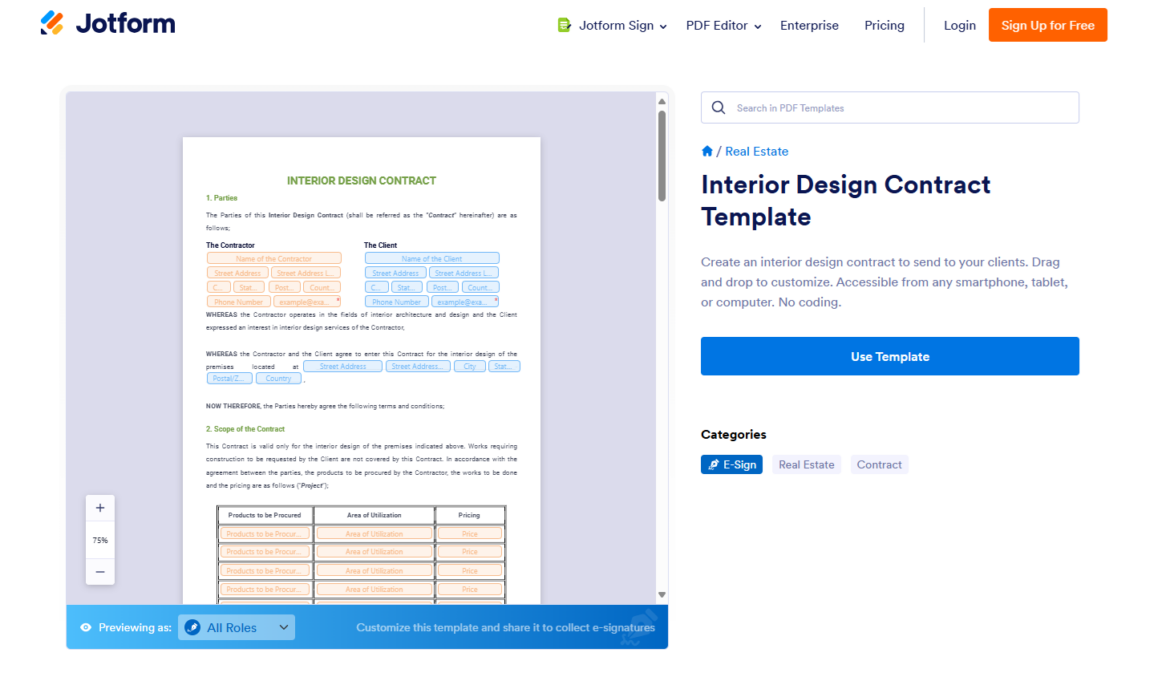
Jotform offers an Interior Design Contract Template that allows you to create a professional agreement outlining the scope of work, timelines, and responsibilities for both designers and clients. Accessible from any device, this template is designed to make managing contracts simple and efficient. You can customize the contract with Jotform’s drag-and-drop builder, adding your branding and unique terms, then share it with clients to collect e-signatures seamlessly.
The template is free to use—all you need is a Jotform account. The free plan allows for up to 5 filled forms per month. If you need to sign more documents, you can upgrade to one of their paid plans.
Features:
- Customizable scope of work and payment terms
- Collect signatures via email, accessible on any device
- Automated reminders and document tracking
- Instantly receive finalized documents after signing
- Free to use with a Jotform account (up to 5 forms per month)
Price: Free
Format: Included within the software
3. Interior Design Contract Template – Papersign
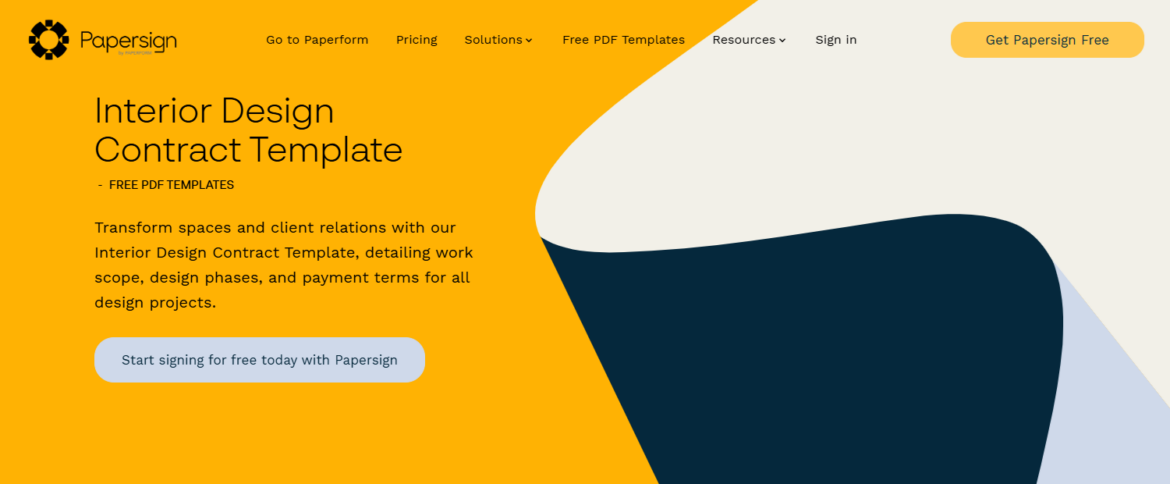
Inside their e-signature software, Papersign includes a free Interior Design Contract Template. This template covers essential elements such as the scope of work, design phases, payment terms, and project timelines, allowing both parties to set clear expectations from the start. Whether for residential or commercial projects, the template can be easily customized with your branding and specific project requirements before being signed electronically.
With a Papersign free account, you can send and sign up to three documents each month without any cost. The platform provides a user-friendly way to manage contracts and signatures digitally, making it a practical solution for designers looking to simplify their workflow.
Features:
- Customizable project scope, timelines, and payment terms
- Easy-to-use digital signatures
- Accessible on any device for both designers and clients
- Secure document tracking and real-time updates on contract status
- Free to use with up to 3 signed documents per month
Price: Free
Format: Included within the software
4. Client Agreement for Interior Designers – Designer’s Oasis
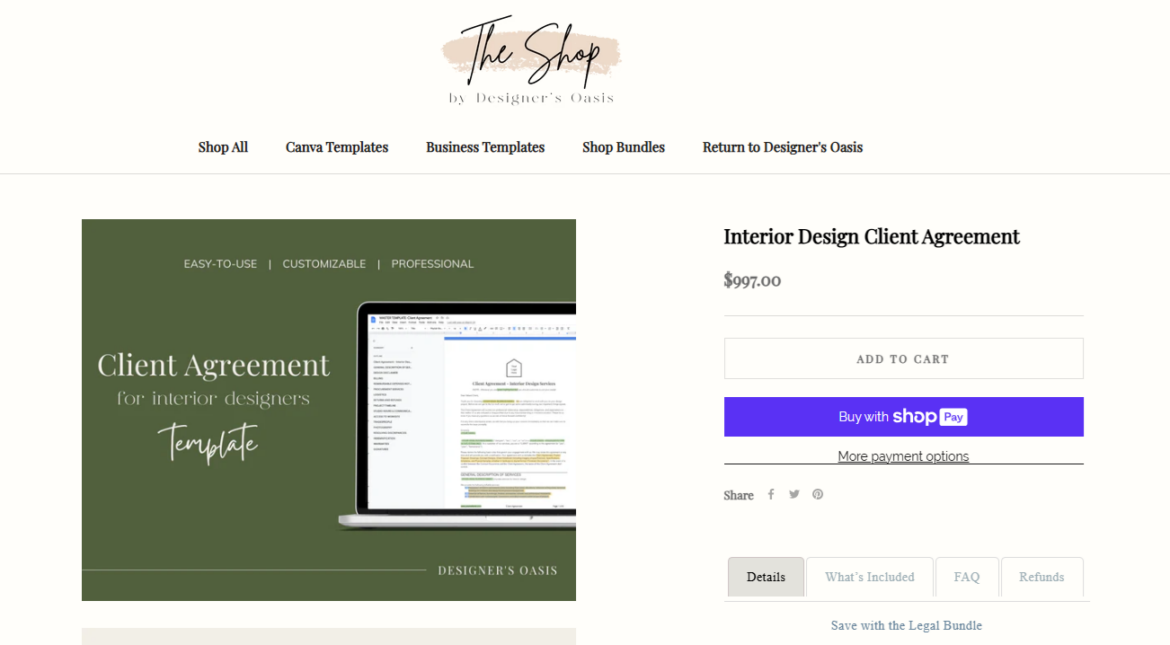
This Client Agreement for Interior Designers is an essential tool for designers who want to protect their business and outline clear expectations with clients. Kate Bendewald of Designer’s Oasis has carefully crafted this contract template. It’s based on real-world experiences in various project sizes, and is simple to use and customize.
This template includes flexibility with three pricing models—flat fee, hourly, or hybrid—and can be tailored for projects with or without purchasing. It comes as an easily editable Google Doc and includes a friendly introduction note for your client, adding a professional and welcoming touch.
Features:
- Scope of services, billing schedules, and payment methods
- Project timelines, warranties, and change orders
- Detailed clauses on revisions, contractor fees, and procurement services
- Client approvals and other project-specific terms
Price: $997
Format: Google Doc
5. Attorney-Written Interior Design Contract – Legal Dash
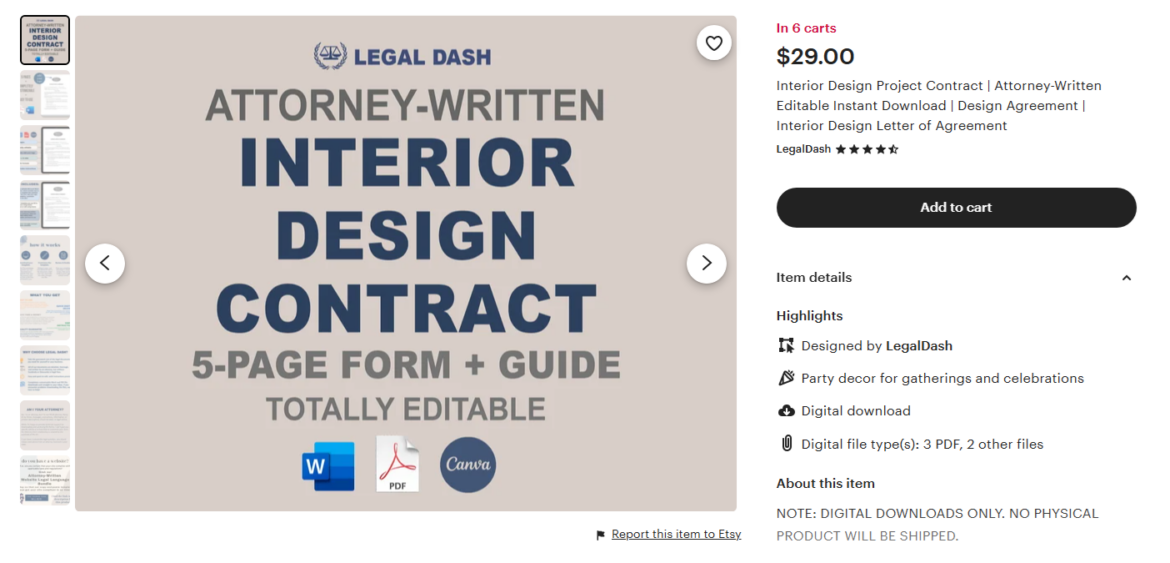
Offered by LegalDash, the Attorney-Written Interior Design Contract is an affordable etsy template. The contract helps you avoid potential disputes, so both parties feel confident throughout the project. The template is downloadable in Microsoft Word and PDF formats. It also includes completion tips from the drafting attorney, making sure you know exactly what sections to update.
With this purchase, you’ll also receive a bonus guide on contracts, explaining what makes them enforceable and how to use them in your business.
Features:
- Scope of work
- Design fees and reimbursable costs
- Cancellations and refunds
- Termination and insurance details
- Independent contractor status
- Jurisdiction and limitation of liability
Price: $29
Format: Microsoft Word
6. E-Design Service Agreement – IDCO Studio
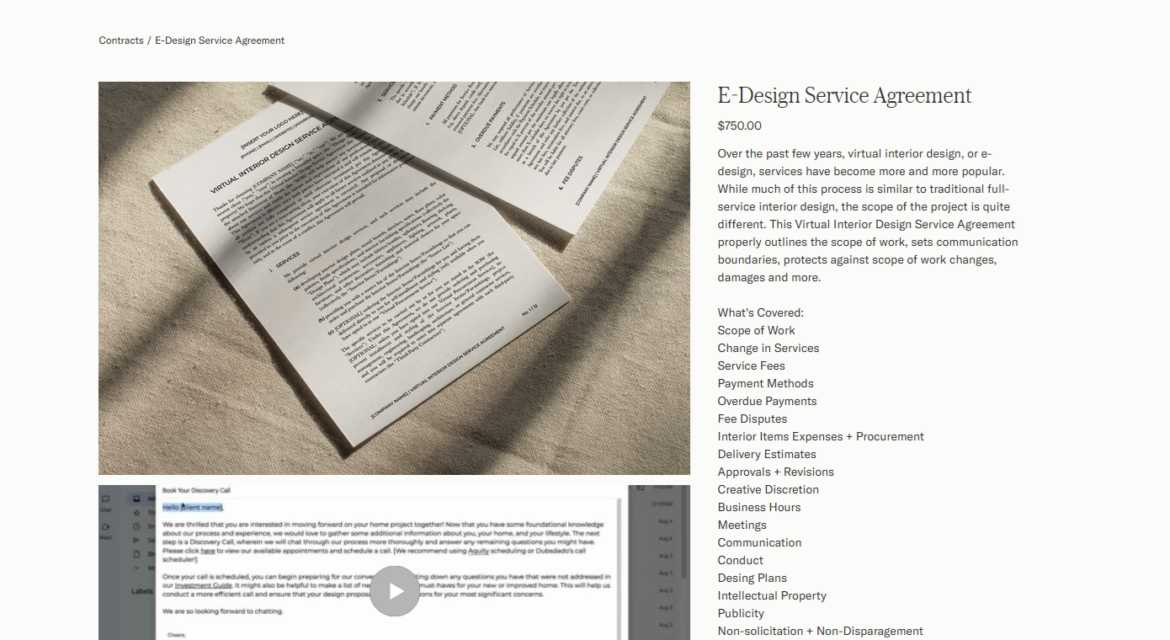
The E-Design Service Agreement by IDCO Studio is tailored for designers offering virtual interior design services (without in-person installations or contractor management). Priced at $750, this comprehensive agreement clearly defines the scope of work and sets essential boundaries for communication and expectations. It protects both the designer and client from issues like scope changes, damages, and fee disputes. It also provides the option to include virtual procurement services or leave procurement to the client.
The contract template is customizable and easy to complete, with highlighted sections for you to fill in and personalize for your projects. Created in collaboration with an attorney, it offers guidance but should still be reviewed by a lawyer for legal compliance in your jurisdiction.
Features:
- Scope of work
- Change in services and fees
- Payment methods and overdue payments
- Approvals, revisions, and creative discretion
- Conduct, meetings, and communication
- Termination and confidentiality
- Limitation of liability and indemnification
- Dispute resolution and force majeure
Price: $750
Format: Google Doc
7. Residential Interior Design Contract – Virtual Interior Design Assistant
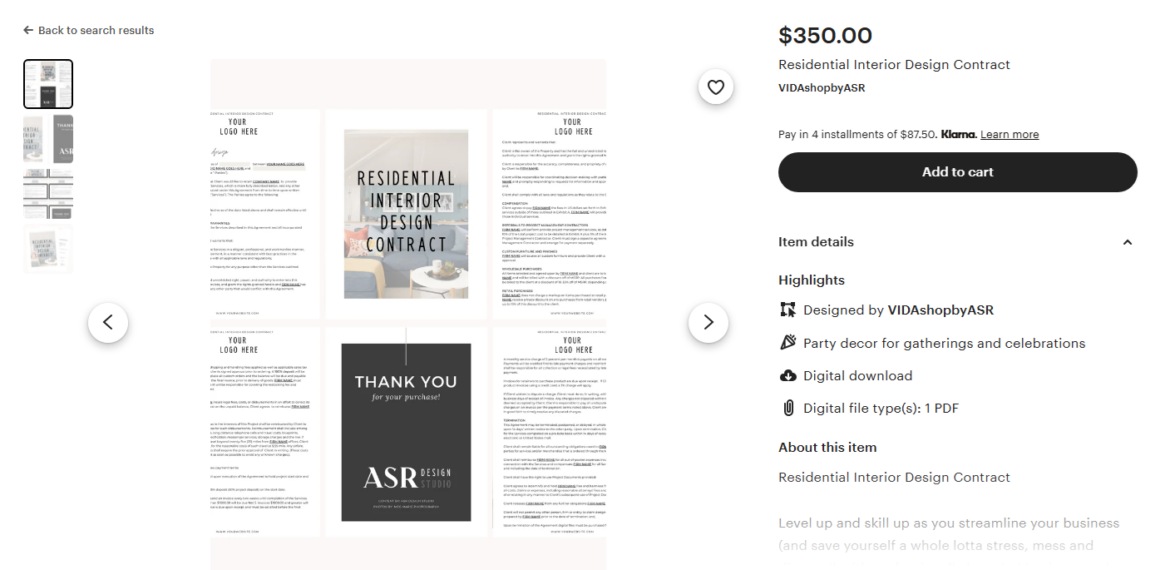
Level up your business and reduce stress with this professionally branded Residential Interior Design Contract by Virtual Interior Design Assistant, a small business that provides templates, CAD drawings, and renderings. Perfect for growing design businesses, this template comes with pre-written verbiage, allowing you to easily customize, save, and share. Impress your clients with beautifully branded, professional client documents that streamline your process while protecting your business.
Features:
- 17 pages covering all aspects of client agreements
- Services, fees, invoices, and purchasing furniture
- Legal fees, termination, confidentiality, and insurance
- Scope of work, photography release, and non-disparagement clause
- Fully customizable Canva template, ready for download and easy editing
Pricing: $350
Format: Canva template
8. Interior Design Contract Agreement Template – House of Huck
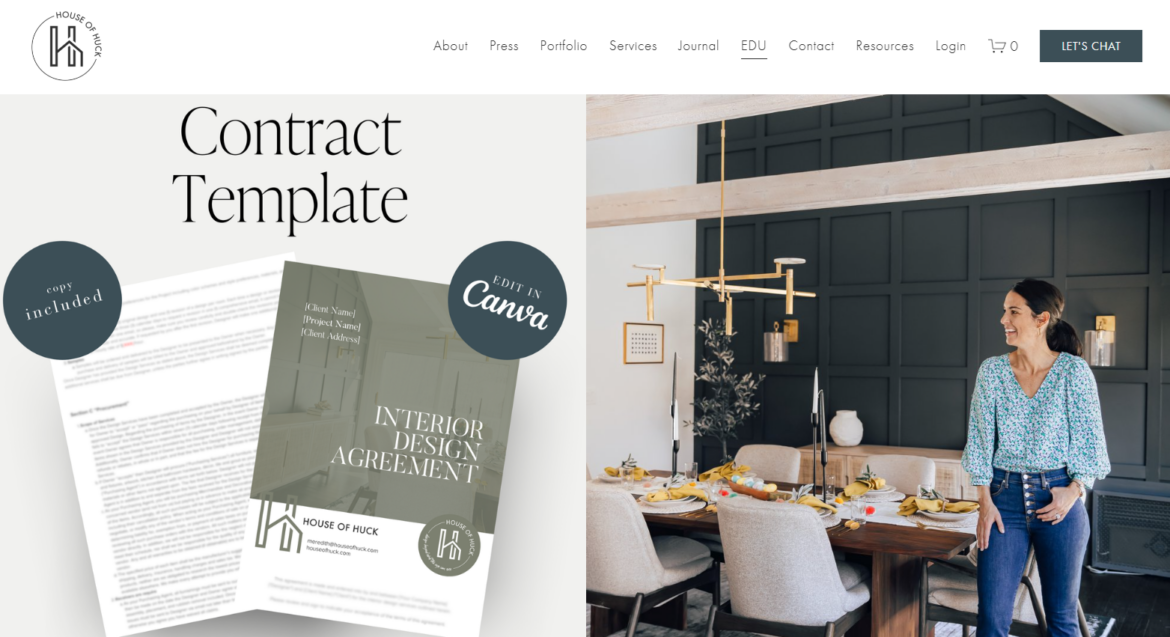
The Interior Design Contract Agreement Template by House of Huck is a versatile solution for designers looking to streamline their project workflows. It’s perfect for both experienced designers and those just starting out. It covers all essential aspects of a project, offering legal protection while promoting clarity between designer and client.
The template is easy to use, even without design experience, and is fully editable in Canva. After purchase, you can customize it with your business details and project information, then save and download the completed contract in your preferred format.
Features:
- Fully customizable text, colors, images, and fonts
- Comprehensive sections for project details, scope of work, and payment terms
- Standard legal terms for protection
- Editable and downloadable through Canva
- Suitable for a wide range of interior design projects
Price: $499
Format: Canva template
9. Interior Design Project Agreement Contract – Insight Design Studio
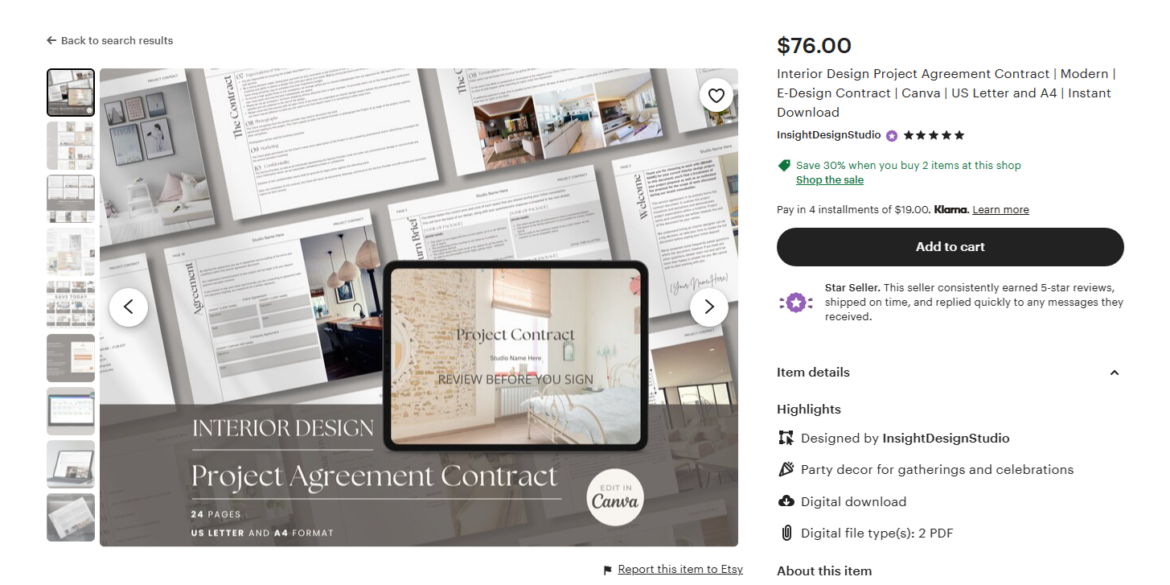
The Interior Design Project Agreement Contract by Insight Design Studio is a modern, fully customizable template designed to simplify contract terms for interior designers, interior decorators, and e-designers. Priced at $76, this 24-page document is easy to edit in Canva, allowing you to reflect your brand and design style effortlessly. The bold, geometric design and customizable content make it a professional solution for managing client expectations and streamlining the agreement process.
With 80% of the text pre-filled, you can quickly personalize this contract to suit your business needs, ensuring a smooth and professional client experience. Ideal for various types of interior design projects, this template comes with detailed instructions and is available for instant download after purchase.
Features:
- 24-page editable project agreement
- Includes cover page, payment schedule, contract, and FAQs
- Pre-filled text (80%), ready for customization
- Fully editable in Canva (free account required)
- US Letter and A4 sizes available for printing
- Instant download upon purchase
Price: $76
Format: Canva template
10. Interior Design Service Agreement – Willow + Jax
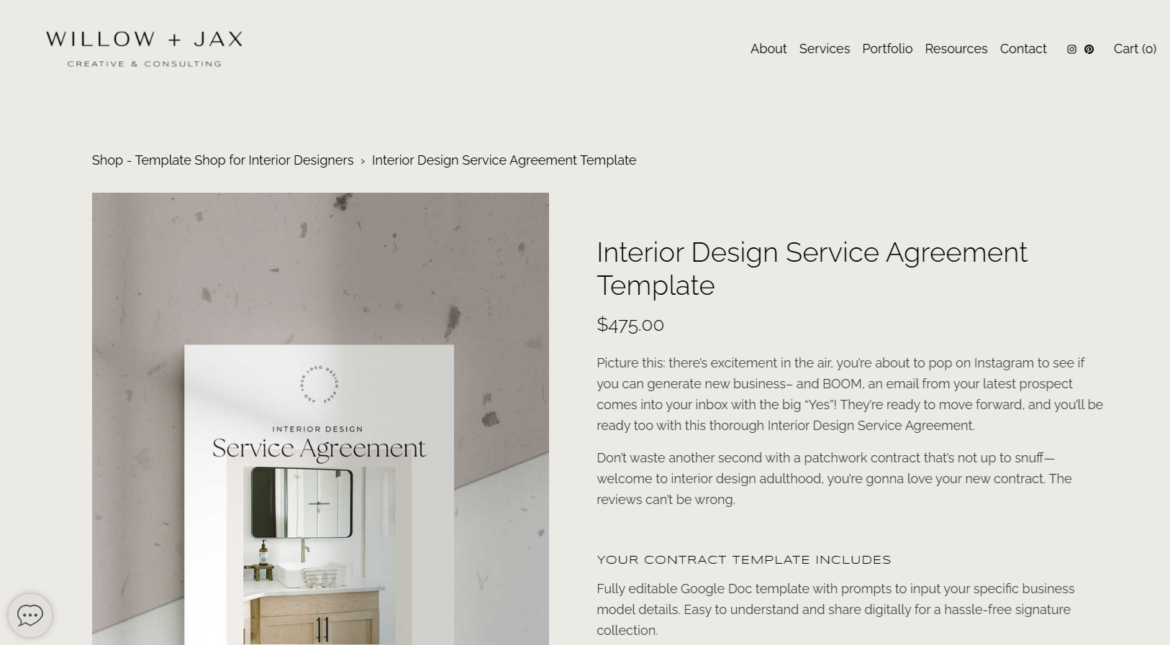
You might also want to consider the Interior Design Service Agreement Template by Willow + Jax. This comprehensive contract sample prepares you to handle every aspect of your interior design projects with clarity and professionalism. Say goodbye to outdated or incomplete contracts—this template provides everything you need to protect your business and streamline client agreements, from project scope to payment terms.
The Google Doc template is fully editable, making it easy to customize for your specific business model. It includes clear prompts to guide you through the process, ensuring all details are covered, and can be easily shared digitally for hassle-free signatures.
Features:
- Editable Google Doc template with prompts
- Detailed terms for services, deliverables, and revisions
- Clear responsibilities for working with contractors and trades
- Guidelines for sourcing, pricing, procurement, and returns
- Clauses for intellectual property, photography rights, and termination
Price: $475
Format: Google Doc
Below, we’ve got details on what your contract should include, provided by interior design business coach Monique Nicole, to help you cover all your basis.
The differences between e-design and full-service contracts
The type of services you provide can affect the content of your contract. Below, we explore some differences between e-design and full service:
- Shopping List Vs. Proposal. With an E-Design service your liability stops after you deliver what I like to call the “Tangibles”. These are the main services that you provide to the client, like the Concept Board, Floor Plan, 3D Design, and Shopping List. And since you provide clients with their own Shopping List, you are not responsible for purchasing their items, which means you are also not responsible for managing the ordering process, shipping, delivery, storage or returns for their purchased items.
- Custom Vs. Retail. Compared to traditional full service, since they will be purchasing items via retail, and not through you via the “trade” you are not responsible as much for the quality and warranty of the product. This can be a big deal especially if the client purchased a custom piece and decided they don’t like the quality once it has been delivered. Custom furniture should be non-returnable. However, if they bought a sofa via retail, they would have an easier time returning it. So your liability increases when offering full service and trade products and you need to make sure you account for that additional liability through your terms and conditions.
- Wholesale vs. Retail. This is a big one. With E-Design, client’s typically shop the look themselves which means you are not adding a mark-up to these items and handling the ordering process. Because of this you lose out on that revenue stream. But you can choose to use affiliate links where you can earn a commission on the sale of each product without having to handle the workload of ordering the products. Just know that if you choose to use affiliate links, you need to add a disclaimer so the client is aware that you’re earning a commission on the sale of these items. This doesn’t affect the price your client pays for the product. They still pay the retail price. The vendor just gives you a commission for facilitating the sale.
- Timing & Rounds of Revisions. There can be major differences between the amount of time you will agree to provide your E-design service, vs. your traditional Full Service option. Mainly because it can take much more time to offer Full Service compared to E-Design. So you will want to lay the expected timing out in your contract.An area to be mindful of, is adding a cap on the number of revisions and updates to the E-Design plan you offer. Specifically, you want to clarify how many revisions they can have for each “tangible” item. Usually up to 2 revisions is a good number. If you’ve done your job and listened well to their preferences and needs of their project, you should hit their vision on the nail by the second round of updates. If not, you many need to go back to the drawing board to understand where the miscommunication is happening. But more importantly, communicating this upfront, and having this detail in your contract will set the stage so the client doesn’t assume that they have endless updates with their project. If your client wants additional rounds of revisions, you can indicate that these extra revisions will be billed at your hourly rate.
In addition, including the number of days they have to purchase their items from the shopping list you provide, can reduce the risk of items going out of stock and the client coming back and asking you to re-source all new items. This is important. This can become a major time suck, if not laid out clearly.
Since we can’t control retail inventory, you’ll want to add a clause that limits the amount of time they have to purchase their items. A good number could be that they must purchase their items within 14 days after approving the design plan. And any additional sourcing requests after the 14 days will be subject to your hourly rate.
Now that you have an idea of the main differences between E-Design & Full Service and what to include in your contract, let’s take a look at the structure of a robust all-inclusive interior design contract.

This doesn’t have to be hard or confusing. You simply want to make sure you have all areas of your business covered as mentioned above. Please keep in mind that the examples provided are geared towards a residential interior design contact, and not commercial. Commercial contacts require different types of terms and it’s always recommended that you seek legal counsel when developing any contract for your business.
The components of a good interior design contract
Learn more about the components of a good interior design contract so you know what to include:
Project Information
- Preliminary Project Information
This area in the contract is where you want to list out the detailed scope of the project including:
- The project areas your firm will be designing/decorating
- The items you discussed you’ll be sourcing for each space
- The proposed decorative budget – (this you should be asking and confirming during your consultation).
- The proposed interior construction budget – (This is the budget the client has to cover any contractor construction work outside of your design fee).
- Budget Estimate – a statement that says your company will provide an estimate but that it can change.
- The Project Team. This is where you can list out anyone who will be working with the client on their project by including their name, title, and address. For example: Lead Designer, Architect, and any Contractors.
Design Services
Scope of Project
In this section, you’ll want to list out the “tangible and actionable” items that you will provide in their design plan. Here you want to be as exhaustive as possible so both you and your client are clear on the terms of this agreement.
Here is an example: On the basis of existing plans or measurements to be taken or confirmed by us, we will, as and where we deem it appropriate, perform the following services:
- Conduct an initial virtual or in-home design consult of existing conditions.
- Discuss with you, your design preferences for each of the Project Areas.
- Provide samples as necessary to generally illustrate our suggested design concepts, including color schemes, interior finishes, wall coverings, floor coverings, lighting, and window treatments for your approval.
- Prepare schematic plans for recommended spaces and decorative details including but not limited to, a concept board, floor plan, 3D board, and/or doll house renderings.
- Prepare suggested layout plans specifying the general location for and the distribution of movable furniture and furnishings.
Our Design Documents that are prepared in this phase of the Project will illustrate our suggested design concepts and will be presented to you for your review and written approval.
The preparation of digital drawings, elevations, renderings, or other detailed drawings for custom millwork, cabinetry, or furnishings are not included as a design service under this Agreement.
Selection of Merchandise
This section is where you will describe how you will select and present the merchandise for their design project. As mentioned before, this is where you may want to break up what you’ll offer in your E-Design service vs. your Full- Service offering.
For example: We will, as and where we deem it appropriate, perform the following services:
E-Design
○ Select and source Merchandise for your Project via retailers and online stores.
○ Provide fabric samples, finish samples, photographs, or other visual illustrations of Merchandise for your consideration.
○ Provide a custom shopping list with product specifications for your approval and purchasing of merchandise.
○ Installation: You will be responsible for receiving and installing all products purchased via the shopping list provided.
Full Service
○ Select and source merchandise for your project via trade manufacturers, retailers and online stores.
○ Provide fabric samples, finish samples, photographs, or other visual illustrations of Merchandise for your consideration.
○ Provide a custom proposal with product specifications for your approval that will be purchased by us.
○ Installation. We will, at the conclusion of the Project, assist you with final placement of your decorative merchandise at your residence.
Purchasing Services
In this section, you’ll want to list out the details on how you will present your merchandise products and pricing, as well as the different pricing models you will bill by, and your order management process.
For example: If you run a E-Design and Full Service business, you’ll want to describe how you will bill for the proposed merchandise for each service.
- E-Design – Each item of Merchandise and Decorative Installations to be purchased & ordered by you will be specified in a Shopping List prepared by us and submitted in each instance for your approval. Each shopping list will describe the item or service to be purchased and its “Specified Price” to you.
- Full Service – Each item of Merchandise and Decorative Installations to be purchased by you and ordered by us, will be specified in a written Proposal prepared by us and submitted in each instance for your approval. Each Proposal will describe the item or service to be purchased and its “Specified Price” to you.
Pricing
- E-Design Pricing: The “Specified Price” of each item of Merchandise and Decorative Installations shall be the retail cost for the item or service.
- Inventory Pricing: The Specified Price for Merchandise sold to you from our own inventory (“Inventory Sale”) will be the price presented in the Proposal (price does not represent our actual cost of such item and includes our compensation).
- Contractor Pricing: The “Specified Price” of each item of Merchandise and Decorative Installations shall be the concerned vendor’s quoted price to you less, if applicable, any discounts usually extended to us (if any).
- Full Service Pricing: In the absence of an established list price (such as Merchandise sold to you from our own inventory (“Inventory Sale”) or custom design decorative Merchandise (“Custom Merchandise”)), the Specified Price of each item in our Proposal, shall be our net cost for the item, plus any applicable delivery, insurance, handling charges, and sales tax. (price does not represent our actual cost of such an item and includes our compensation).
Ordering & Payments
In this section, you’ll want to say how you will process payments, and when monies will be due.
For example: All Merchandise and Decorative Installations specified by us will, if you wish to purchase them, be purchased solely through us (except that we may, from time to time, ask that you directly engage the services of third parties to provide Decorative Installations in accordance with the provisions described elsewhere in the Agreement).
No item can be ordered by us until the corresponding Proposal has been approved by you and returned to us with our required “initial” payment which shall be (100%) of the Specified Price.
(“Initial Payment”).
NOTE: I highly recommend that you require 100% of payment up front after the proposal has been approved, because of insurance reasons. Not until the client has paid in full, does the “ownership” of the item become theirs. So for example, if a sofa gets damaged on route to their home, but they haven’t paid in full, it’s technically still owned by you, and you would be responsible for the item.
Order Management
In this section you’ll want to explain how you plan to manage the process of ordering the client’s merchandise.
For example:
For our Full Service Packages, we will assist in (a) managing your orders and following up with vendors regarding any delays or errors in processing your orders; and (b) scheduling and coordinating deliveries with vendors to your residence, or if you are unable to take immediate delivery of any Merchandise or store such Merchandise at your home, to a storage facility that has been selected by us or you and with whom you have entered into a contract.
For our E-Design Packages, you will be responsible for (a) managing your orders and following up with vendors regarding any delays or errors in processing your orders; and (b) scheduling and coordinating deliveries with vendors to your residence.
Project Administration Services
This area is where you discuss any administrative or vendor project management work and what you are responsible for.
For example: During the course of the Project, we will visit your residence from time to time as we deem necessary to see whether, in our opinion, the work of any contractor, subcontractor, or vendor is proceeding in general conformity with our Design Documents (“Project Administration Services”). We are not responsible, however, for the performance or timely completion of any of their work or of any materials or equipment furnished by them.
Designer Compensation
This is the area where you get to list your design services and pricing. (My favorite section in the contract). You’ll want to include the name of the service, the price (if it’s a package and you are able to share the full price) and the payment terms (when the service has to be paid).
For example:
E-Design
Virtual Design Package – $795.00 (Per Room)
Paid In Full Upon Receipt of Invoice
- 30 Minute Phone Consultation
- Concept Board
- Floor Plan
- 2D Board
- 3D Rendering
- Shopping List (Retail Only)
- Designer How-To Guide with Notes
Custom Design Services
Custom: Include your hourly rate for any custom design services not included in the price
Hourly Design Fee Agreement Here you’ll want to list your hourly rate for each staff member should the client want to hire you for additional services, and you have different rates for different people on your team.
| ● Principal | $[110] per hour |
| ● Associate Designer | $[95] per hour |
| ● Administrative | $[75] per hour |
| ● Renderings | $[110] per hour |
| ● Installation | $[110] per hour |
Note: It’s a good idea to list any services that are NOT included in the design fees.
For example: Our Design Fee does not include drafting/rendering time in connection with Custom Merchandise or any service not specifically provided within the Included Services. If we provide any services to you or on your behalf outside of those Included Services, time expended by us will be billed to you at our Hourly Rates set forth below.
(here you can list all of the things that are not included).
Terms and Conditions of Sale
This section will outline all of the terms and conditions that apply to the entire agreement.
They will also apply to third-party Decorative Installations such as painting services, upholstering, installation of Merchandise.

Below are a few areas you may want to consider explaining any special terms for:
- Price Changes
- No Cancellations or Returns
- Product Taken on Approval
- Failure to Make Payments when Due
- Sales Taxes and Other Charges
- Delivery is Approximate
- Client’s Failure to Accept Delivery
- Receiving, Uncrating, and Inspection of Merchandise
- Carrier as Agent of the Client.
- Storage and Warehousing
- Sale of Antiques and Art
- Limitation of Liability
Termination Rights
Termination for Cause & Without Cause – this is where you discuss how the contract can be terminated if there is a cause or there is no cause. Typically you’ll want to give each party 20-30 day termination notice if terminating for cause. Without cause usually provides a 10-20 day window to cancel the contract. Also it should include that the termination for cause shall be without prejudice.
- Make sure to specify that in addition, the client shall be obligated to pay all monies due under the Agreement (including, but not limited to, unpaid invoices, Design Fees, Hourly Rates, and other Designer compensation, and Reimbursable Expenses (whether or not such invoices have been rendered)), and reasonable hourly charges and expenses incurred subsequent to termination in connection with any transition services requested by the client.
Dispute Resolution
In this section you want to confirm where (which county and state) you will go to court in, which state you want the law to be governed by, and that you both agree to try to settle the dispute through mediation should a dispute arise. Whether you are offering full service design services or e-design services, you’ll want to state that all disputes will be handled within the city and state that you do business in.
Additional Terms & Conditions
- Design Documents. In this section, you can discuss that all documents are conceptual in nature and are not guaranteed to be subject to code. For instance if you are not an Interior Designer but a Interior Decorator. Include that the onus also lies on the client to ensure that he or she provides accurate information to the designer. It should also be made clear that the documents must not be used by the Client for any purpose other than what is laid out in the interior design agreement.
- Use of Design Related Professionals and Third Parties. This clause should hold you harmless on any contractor’s work or disputes.
Here is an example clause: Should the nature of our Design Documents require the services of third-party professionals, consultants, or contractors (“Design Related Professionals”) or other third parties to perform work based upon our Design Documents, you agree to enter into separate agreements directly with each of them, under terms that are mutually acceptable to you both. To the extent that we may review any construction documents (or other documents) prepared by them or by any other person, please know that our review is for the sole and limited purpose of achieving general compliance with our aesthetic concepts and overall design intent. - Your Responsibilities to Us. This section should include what you need the client to be responsible for during the design process such as giving you access to their project site, giving timely, non-delayed feedback, and ensuring that they pay any costs associated with storage, insurance, and transportation.
- Independent Purchases. This details any purchases that are purchased by the client but that was advised by your firm. Remember if you choose to use affiliate links, you need to add a disclaimer so the client is aware that you’re earning a commission on the sale of these items.
- Reimbursable Expenses. Reimbursable Expenses will be billed to you at their actual cost to us plus a twenty (20%) percent service charge for administrative time.
- Ownership and Use of Design Documents. This section will describe the terms around the use of the design plans you provide the client, and that they are your property, and are subject to copyright. It also should lay out how the client can use the documents, based on your approval.
- Indemnification. This clause simply states that you are held harmless from and against any and all third-party claims, losses, liabilities, damages, costs, and expenses.
Here is an example clause: To the fullest extent permitted by law, you agree to indemnify and hold us harmless from and against any and all third-party claims, losses, liabilities, damages, costs, and expenses (including reasonable attorneys’ fees and related costs) (each a “Claim”, and together “Claims”) relating to, arising out of or resulting from the actions and omissions of you and/or of any Design Related Professional, construction contractor, contractor, subcontractor, vendor, tradesperson, supplier, agent, or other third party hired or otherwise retained by you or on your behalf. - Limitation of Liability. This clause will state the limitation of liability in case a dispute arises.
Here is an example clause: To the fullest extent permitted by law, our total liability to you in regard to any and all claims, losses, and damages arising out of, relating to or resulting from this Agreement or the services performed by us pursuant to this Agreement, shall not for any reason exceed the greater of (i) the total amount of Design Fees and other Designer compensation actually paid to us pursuant to this Agreement; or (ii) the available proceeds of our insurance policies, if any, and if applicable. Under no circumstances shall we be responsible for (a) any indirect or consequential damages; or (b) any injury, loss, damage or delay caused by any reason beyond our reasonable control. Also, we are not responsible for the actions or omissions of any Design Related Professional, construction contractor, contractor, subcontractor, vendor, tradesperson, supplier, agent, or other third party, even if we recommended them to you. Additional limitations of liability regarding the sale of Merchandise to you is set forth in the “Terms and Conditions of Sale” section in this agreement. No action against us for breach of this Agreement or otherwise may be brought more than one (1) year after the date of the accrual of such cause of action. - Consent to Photograph Project. This clause states that your firm will require a permanent record of your design projects, and that the client will permit you or your representatives to photograph, video and/or otherwise record images of the Project Areas and their residence before, during, and after Project completion. In addition, you’ll want to confirm how the Photograph(s) will be used (for business purposes including publication). And if any project-related Photograph(s) are published by your firm, you will not identify their name and address in any such publication without their prior written consent.
Frequently asked questions
Get answers to FAQs about interior design contracts.
Your interior design contract should outline the scope of work, project timelines, payment terms, and a clear process for revisions and approvals. Include clauses on confidentiality, termination, and photography rights, especially for before-and-after shots. It’s important to define each party’s responsibilities, handling of extra fees or changes, and a dispute resolution process. This ensures you and your client have a clear understanding and avoids misunderstandings.
That’s up to you and your comfort level. You can start with an interior design contract template to save time and cover the basics, but it’s wise to have a lawyer review it. A lawyer can tailor the contract to your specific services and make sure it complies with local laws, giving you added protection and peace of mind.
You can find free interior design contract templates on platforms like Jotform and Papersign. These options are customizable and allow you to collect e-signatures, making them convenient for managing your projects. Simply sign up for a free account to access these templates and start using them for your design projects.
Please Note: The information provided in this blog is not intended to provide legal advice in any way. When creating any form of business contract it is advised to seek legal advice.
Ready to streamline and grow your business? Meet DesignFiles, the top-rated platform for solo and small design firms.


